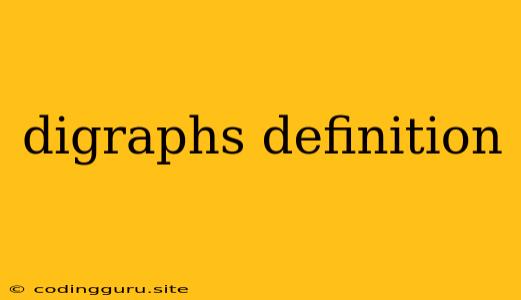What are Digraphs? A Comprehensive Guide
Digraphs, in the realm of linguistics and phonetics, hold a crucial position in understanding the intricacies of pronunciation and spelling in various languages. This article delves into the definition of digraphs, exploring their characteristics, examples, and significance.
Defining Digraphs: A Duo of Letters with One Sound
A digraph is essentially a combination of two letters that represent a single sound. These combinations are not simply two letters pronounced individually but rather function as a unit to produce a specific sound. The sound represented by a digraph may or may not be the same as the sound of either individual letter.
Let's take the English word "ship" as an example. The letters "sh" together form a digraph that represents the /ʃ/ sound, a sound not produced by either "s" or "h" alone.
Types of Digraphs: A Closer Look
Digraphs can be categorized into two primary types:
- Consonant Digraphs: These digraphs represent a single consonant sound. Examples include:
- ch in "chair"
- th in "thin"
- ph in "phone"
- Vowel Digraphs: These digraphs represent a single vowel sound. Examples include:
- ai in "rain"
- ea in "bread"
- oo in "moon"
Digraphs Across Languages: A Global Phenomenon
The use of digraphs is prevalent across numerous languages, each with its own unique digraph combinations. For instance, in Spanish, the digraph "ll" represents the /ʎ/ sound, while in German, the digraph "ch" can represent different sounds depending on its position within a word.
The Importance of Digraphs: Enhancing Communication
Digraphs play a vital role in ensuring effective communication. They provide a means to represent sounds that cannot be conveyed by a single letter, promoting clarity and consistency in written language. Understanding the various digraphs used in a language allows individuals to correctly pronounce words and interpret written text.
Digraphs and Spelling: A Potential Source of Confusion
While digraphs contribute to a more efficient writing system, they can also introduce challenges for learners. The same digraph can sometimes represent different sounds in different contexts. Consider the digraph "ough" in English:
- though /ðoʊ/
- through /θruː/
- enough /ɪˈnʌf/
This variability can lead to difficulties in spelling and pronunciation, especially for non-native speakers.
Conclusion: Digraphs - A Crucial Element of Language Systems
Digraphs are essential elements in language systems, contributing to the representation of sounds and facilitating accurate pronunciation and interpretation of written text. Although they can pose challenges in terms of spelling and pronunciation, understanding digraphs is fundamental for mastering a language and achieving clear communication.
